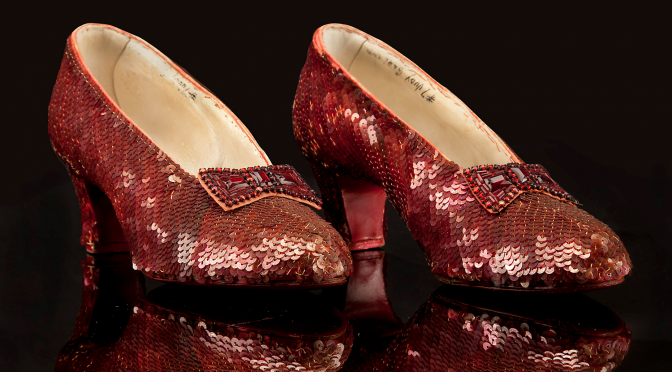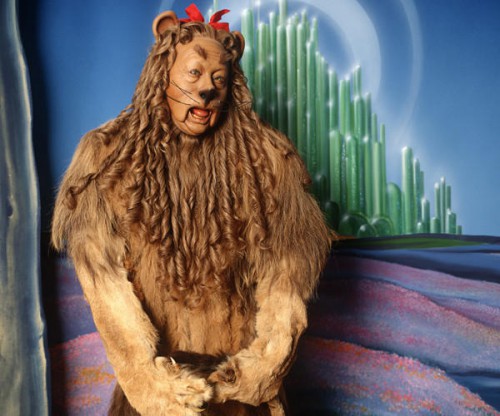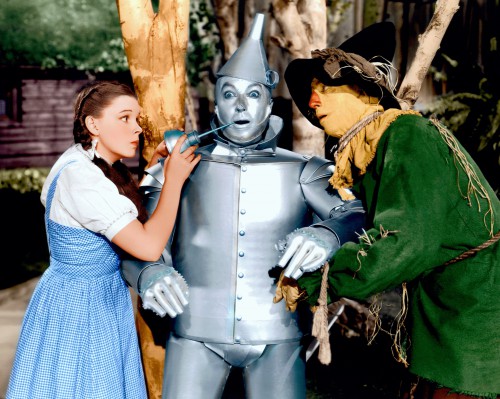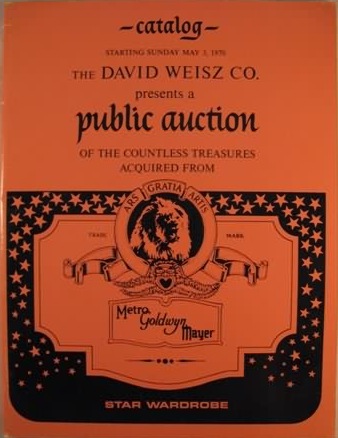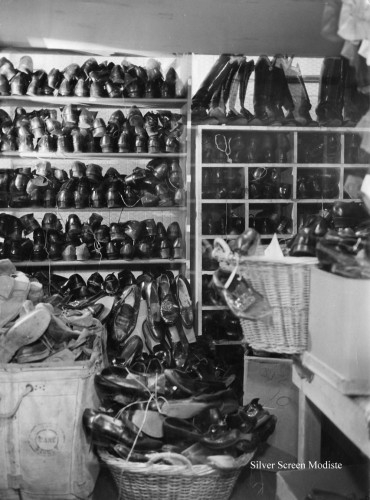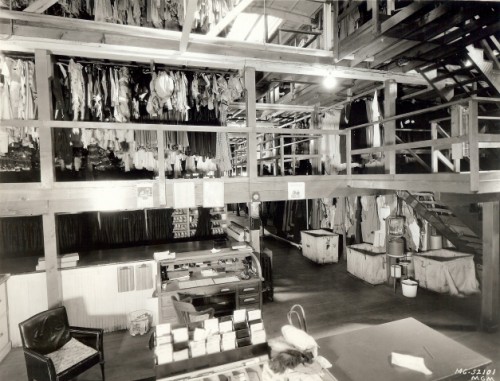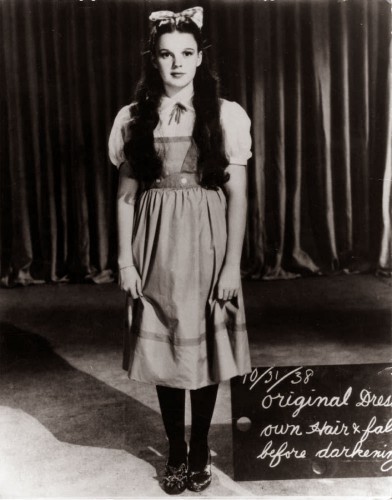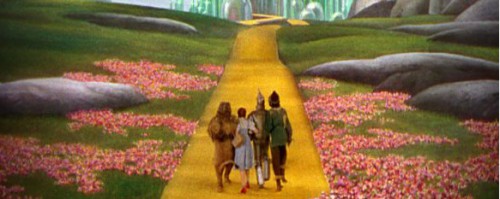The vintage costumes from the immortal The Wizard of Oz have, along with those of Marilyn Monroe, set records for Hollywood memorabilia at auction. Stored in MGM’s wardrobe Department warehouses for decades, then liberated, they quickly turned hands and escalated in price. As outlined in my previous post, the one exception was the pair of Ruby Slippers that had been awarded as a contest prize by MGM to high school student Roberta Jeffries in 1940. She had treasured her pair until 1988 when she sold them at auction for $165,000. Roberta was flabbergasted by the price, as was everyone. The buyer was Anthony Landini, who then loaned them to Disney World for permanent display. The amazing thing was that at this point it was well known that these were not the only pair of Ruby Slippers.
The inked #7 pair of Ruby Slippers originally found by Kent Warner. Why were there more than one pair? It was common studio practice to have multiple pairs of costumes, and especially for plot-driving accessories like the Ruby Slippers. If they were damaged during filming, production would have to be halted, especially as Dorothy and the other key characters wore their costumes through virtually the entire movie.

There were also stand-ins or stunt-doubles that had the same costumes. And in the case of the The Wizard of Oz, Judy Garland also wore variant copies of the blue pinafore dress in test photos and in early scenes that were subsequently re-shot under the new but still temporary director George Cukor. While these were not the classic blue and white gingham pinafore used in the film, demand is so strong for anything OZ that values have escalated for these costumes as well.
Dorothy’s pinafore has reached very high prices, even when made in several copies and in variant colors. The same dress has also reappeared at auction several times. Kent Warner found several Dorothy pinafores in the MGM Wardrobe. The first one sold at the 1970 MGM auction for $1000. A few others he kept for himself. In 1981 he consigned to Christie’s East one of the classic blue and white gingham pinafores with an off-white blouse. It bore a label with Judy Garland’s name and the number 4461. It sold for an unknown amount. All of the variant Dorothy dresses were designed by Adrian. The Wizard of Oz was an international phenomenon in the Anglo-Saxon world. Bonham’s Knightsbridge in London sold at auction a Dorothy blue and white gingham pinafore without the blouse in 2005 for the equivalent of $270,000, setting the record at that time, the company announced.
A test pinafore of all-blue with gingham trim and off-white blouseThe market started heating up again when Debbie Reynolds held the first of her two auctions run by Profiles in History on June 18, 2011. She was selling off her collection to pay off the debts of her bankrupt foundation, and the auction had been getting national publicity for months. Additionally, many of the costumes had been on exhibit long in advance of the auction and thousands took advantage of viewing the collection at the Paley Center in Beverly Hills. Among the many treasures from Debbie’s amazing collection was the solid blue pinafore and off-white blouse shown above. This was one of the test dresses not used in the film. Amazingly, it sold for $920,000. This got people’s attention, as did the prices for all the other notable costumes from Debbie’s costume and Hollywood artifact collection. Debbie’s pair of the rather beat-up test pair of the “Arabian” slippers” went for $510,000, reportedly destined for the Middle-East. There is nothing like very high prices to shake the collectibles tree.
The next Dorothy dress to appear at auction was the blue and white gingham pinafore dress actually worn by Judy Garland in the movie. It came up for sale at the Julien’s auction of November 10, 2012. It also has the original blouse and was in fact the same costume consigned by Kent Warner to Christie’s in 1981, bearing the label with Judy Garland’s name and the number 4461. This dress sold for $400,000. Considering the $920,000 price minus the fees and taxes paid for the Debbie Reynolds dress, this iconic dress was a bargain. Although the dress is a bit faded from time, and it was purposefully dyed in muted whites, the photo below does not do the costume justice.
Judy Garland’s movie-worn Dorothy dress. So the next Dorothy dress to hit auction came quickly. Long-time Hollywood memorabilia collector and Judy Garland fan Barry Barsamian had another all-blue Dorothy dress, only this one had actually been used in the first two weeks of filming. This filming had been done under OZ‘s first director, Richard Thorpe, before he was replaced. Barry Barsamian had gotten the dress from Wayne Martin, who in turn had gotten it from Kent Warner. This dress had been loaned as part of the Smithsonian’s “Freedom Train” celebrating the American Bicentennial. This dress is shown below. It sold at Profiles in History on July 28, 2013 for $300,000.

Also a beloved character from the movie was the Cowardly Lion, played by Bert Lahr. As mentioned in the last post, this costume was made from real lion pelts. It too was sold at the MGM auction in 1970. At that time the costume was missing its two front paws and its mane and ears. It sold nonetheless for $2,400, more than twice what Dorothy’s pinafore originally sold for.
The Cowardly Lion costume had been owned for many years by James Commisar, who had it restored. He had the face molded on that of Bert Lahr’s son; John Lahr. The mane was remade. Comisar is a collector of television history artifacts and he is planning a museum of television history. It is to this end that putting up for sale the Cowardly Lion costume would help his fund raising drive. He had the costume consigned to Profiles in History in 2011 but it failed to sell at its high reserve price of $2 million. Profiles in History subsequently sold it for $805,000 on Ebay.
The Academy of Motion Pictures Arts and Sciences Herrick Library owns the Cowardly Lion mane and ears that may have been the match to the costume above, but in any event are original to the 1939 Wizard of Oz production. They are shown above.
And miracle of miracles, that most fragile of costumes, the Scarecrow’s has survived. As mentioned in the last post, Ray Bolger saved his costume, including the raffia that served as hay, after production wrapped. His wife Gwendolyn donated the costume to the Smithsonian in 1987, along with a bag of raffia.

But other significant pairs of Ruby Slippers were out in the world. One pair went around the country on the exhibit tour, owned by noted Hollywood costume collector Michael Shaw, who had of course gotten his pair from Kent Warner. He had loaned his pair to the Judy Garland Museum In Grand Rapids Minnesota. In a bizarre case, the pair were stolen from the museum, and their whereabouts took years to solve.
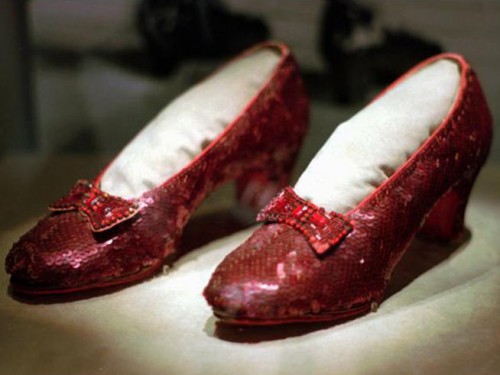
Profiles in History managed to land another pair of the Holy Grail of Hollywood collectibles: the Ruby Slippers with the provenance of Kent Warner, a subsequent auction purchaser, then Philip Samuels. These were the pair in the best condition and the most likely to have been the pair used in the close up shot, where Judy Garland taps her heels three times and wishes she could go back home. The pair of Ruby Slippers went up for auction on December 15, 2011 with a reserve price of $2 million dollars.
These most famous of Ruby Slippers and the most treasured Hollywood icon did not sell. After the auction Leonardo DiCaprio and Steven Spielberg purchased the slippers for donation to the Museum of the Academy of Motion Picture Arts and Sciences. How fitting an end that they should not only stay in the U.S but stay very near to Hollywood. Bravo to Mr. DiCaprio and Mr. Spielberg.
Their magic must be very powerful, or they wouldn’t want them so badly.
Views: 3694

